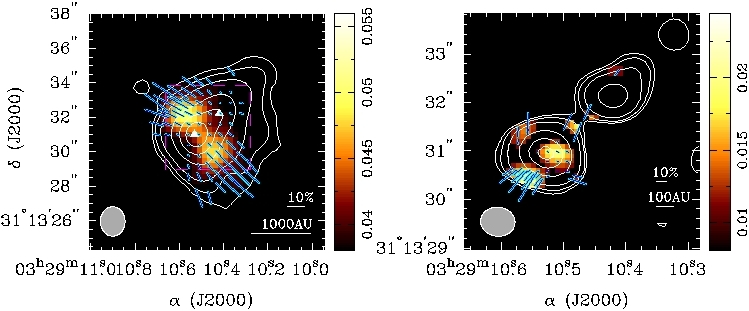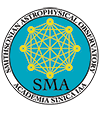|
Magnetic field maps of NGC1333 IRAS4A. LEFT: This map is made from SMA data taken in the subcompact, compact, and extended array. The contours represent the total intensity (Stokes I) at the level of 3, 5, 10, 30, 60, 90 x 26.2 mJy/beam. The color image shows the polarized intensity. The line segments indicate the magnetic field directions with their lengths proportional to the polarization percentage. The dashed rectangle marks the region presented in the right figure. RIGHT: Same as the LEFT figure, but only visibilities with spatial frequency greater than 75 kilo-wavelength are used. The contours are at 3, 5, 10, 30, 60, 90 x 11.8 mJy/beam.
We present the first map of the toroidal magnetic field structure in a disk around protostars. The magnetic field in the low-mass protostellar core NGC1333 IRAS4A (hereafter IRAS4A) have an hourglass morphology in the scale of few thousands AU (Girart et al. 2006, SMA data). Here we further explore the magnetic field structure within the central 1000 AU region of IRAS4A with the sub-arcsecond resolution dust polarization SMA data at 345 GHz. Our results reveal that except for the regions perpendicular to the center of IRAS4A1, the magnetic field appears to be parallel to the disk that contains the protostellar binary, IRAS4A1 and IRAS4A2, and perpendicular to the large scale hourglass structure. This field geometry is in agreement with the expectation of star formation models with ideal MHD condition; that is, if the magnetic field were frozen in the accreting material, it would be dragged into the direction parallel to the disk around the protostar by the rotation of the disk. Near IRAS4A1 the field direction is consistent with the large-scale field direction, which implies the disk has an inner hole around the protostar.

Shih-Ping Lai (National Tsing-Hua University, Taiwan), 2009
| 

